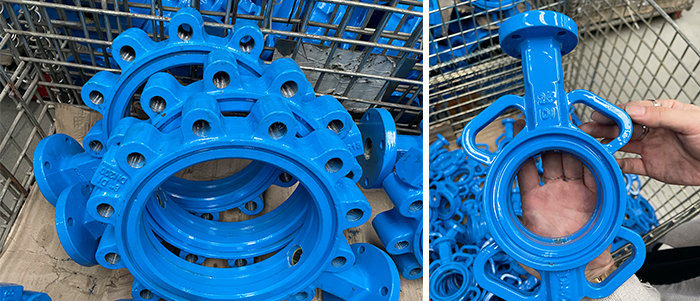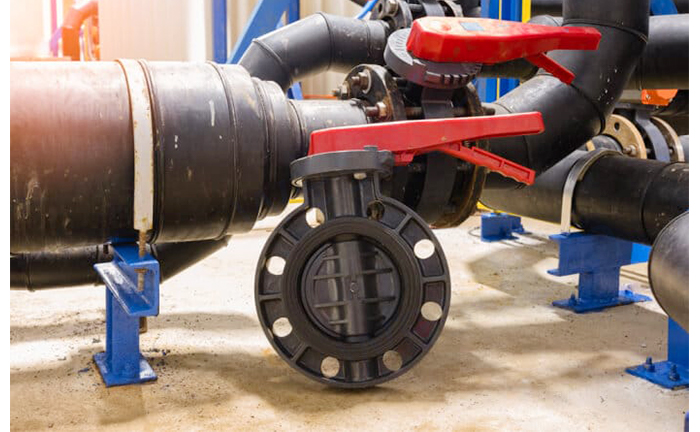- Gate valve
-
- DN1000 Extension stem double flange soft seal gate valveDIN F4 resilient seated gate valveDN450-1200 Resilient Seated Gate ValveDIN F5 resilient seated gate valveSocket connection soft seal gate valveUnderground cap soft seal gate valveBS5163 rising stem soft seal gate valveHard seal gate valveAPI slab Gate ValveStainless steel flange gate valveWafer knife gate valvePneumatic gate valveSoft seal gate valveExtension stem gate valveUL/FM fire protection groove ends gate valveRising stem forged steel gate valvecarbon steel gate valveStainless steel threaded gate valveDIN soft seal gate valveANSI soft sealing gate valve 200PSICast iron gate valveBS resilient seated gate valve
- Butterfly valve
-
- DN900 pneumatic triple eccentric hard seal butterfly valveD643H Triple Eccentric Butterfly ValveD343H Hard seal butterfly valveMulti standard EPDM seated butterfly valveSingle flange butterfly valveDN2000 Double eccentric butterfly valveFlange butterfly valveLug butterfly valveWafer butterfly valve with handleWorm gear operated butterfly valveWafer lined fluorine butterfly valveStainless steel wafer butterfly valveStainless steel flanged butterfly valveThree eccentric flange butterfly valvePneumatic flanged butterfly valvePneumatic wafer butterfly valveTriple eccentric butterfly valve wafer typeWafer butterfly valve ULC approvedInflatable seat butterfly valveHigh performance butterfly valveGrooved end butterfly valveElectric soft seal butterfly valveFlange fluorine lined butterfly valveHandle aluminum butterfly valveWorm Gear Aluminum Butterfly ValveFull PTFE lined butterfly valve wafer typeOne stem no-pin wafer butterfly valveMulti standard aluminum stem butterfly valveStainless Steel wafer Butterfly ValveAluminium handle operated lug butterfly valveLever Operated Flange Butterfly ValveButterfly valve stemButterfly valve discButterfly valve seat
- Ball valve
-
- DN1400 top-mounted eccentric semi-ball valveFlanged three-way ball valveFully welded ball valveNatural gas ball valveHigh platform flange ball valve1 PC ball valveFixed ball valvePTFE seat flanged ball valveMetal seat ball valveAPI 6D ball valve3 Piece ball valveFull Bore 3 way ball valve L-Port3 Way T-Port ball valve2PC Ball valve female thread stainless steel
- Globe Valve
-
- API Carbon Steel Globe ValveBellows Globe ValveStainless steel flange globe valveStainless steel thread S type globe valveStainless steel thread B type globe valveCast Steel Globe ValvePiston Globe ValveWCB Carbon Steel Globe Check Valveelectric motorized control stainless steel SS316 globe valveBrass Globe ValveCryogenic Globe valveHT200 Globe ValveThreaded Stainless Steel Globe ValveGG25 Globe ValveANSI API Cast Steel And Stainless Steel Globe valve
- Check valve
-
- Rubber seal check valveDN800 Slow closing check valveDN800 Rubber Disc Check ValveButterfly Buffering Check Valvecheck valve with counter weightSilent Check ValveWCB Swing check valveSwing Check ValveSingle Chip Check Valve H74WStainless Steel Wafer Check ValveSwing Start Check ValveFoot check valveAPI Swing Check ValveDIN Flange check valveSingle plate check valveLifting Check ValveBottom ValveHammer Diminish Noises Check ValveWafer Check ValveWafer dual plate check valve
- Control valve
-
- Static Balancing ValveCage Guided Sleeve Globe Control ValveDN1000 Piston Flow Regulating ValveDN1600 Electric Actuator Flow Regulating ValvePneumatic Flanged Butterfly ValvePneumatic Wafer Butterfly ValveAngle Seat ValvePneumatic gate valveElectric three-way control valveElectric sleeve control valve
- Water Meter
-
- Vertical Type Water MetersStainless steel threaded water meterPiston water meterPlastic water meterMore flow rotor dry water meterspiral vane flange water meterCI wotlman water meter with pulse outputLXCLG(R) Vertical removable element woltman cold (hot) water meterSingle flow rotor dry water meterPrepaid Token Water MeterElectromagnetic flowmeterRotary Piston Liquid Sealed Water MeterRotary Piston Liquid Sealed Water Meter
- Air valve
-
- Double ball exhaust valveDoubleair Air Valve SaudiDoubleair Air Valve Southeast AsiaDoubleair Air Valve South AmericaDouble Air ValveThreaded Air ValveSingle Air ValveTriple Functions Air ValveAutomatic Air Release ValveAutomatic release valveAutomatic exhaust valveComposite Exhaust Air ValveBrass exhaust valveDouble Ball Air Valve
- Pipe Repair & Coupling
-
- Flexible Multi-Function Pipe Coupling ZFJ-SSS Semi-Circle Pipe Repair Clamp SJW-HDuctile Iron Band Repair ClampStainless Steel Band Repair ClampDouble-Section Pipe Repair CouplingFolding Type Pipe RepairSingle-Section Multi-Function Pipe Coupling MF-SGear-Ring Type Multi-Function Pipe Coupling GR-SZBW Damping Corrugated Hose
- Dismantling Joint
-
- VSSJAFC(CC2F) Detachable Flange Transmission JointVSSJA-2(B2F) Double Flange Limited Expansion JointVSSJA-1(BF) Single Flange Limited Expansion JointVSSJA(AF) Flange Loose Expansion JointJGD-B Threaded Rubber JointZBW Damping Corrugated HoseKXT-S Flexible Dual-Spherical Rubber JointKXT Rubber Soft JointFlange Adaptor
How butterfly valve work?
Definition of butterfly valve.
Butterfly valve, also called a flap valve, is a simple structure of the regulating valve, can be used for low-pressure pipeline media switch control of the butterfly valve is the closing member (valve flap or butterfly plate) for the disc, rotating around the valve shaft to achieve the opening and closing of a valve.
The valve can be used to control the flow of various types of fluids such as air, water, steam, various corrosive media, slurry, oil, liquid metal, and radioactive media. The pipeline mainly plays a cutting-off and throttling role. The butterfly valve opening and closing member is a disc-shaped butterfly plate, in the valve body around its own axis rotation, so as to achieve the purpose of opening and closing or regulation.
The working principle of butterfly valve.
The butterfly valve is a valve that uses a disc-type opening and closing member to open, close, or regulate the flow of media by turning back and forth about 90°. Butterfly valve not only has a simple structure, small volume, lightweight, material consumption, small installation size, small driving torque, and easy and rapid operation, and can also have a good flow adjustment function and closure sealing characteristics, which is one of the fastest growing varieties of valves in the last decade. Butterfly valves are used very widely. The variety and number of its use continue to expand, and to high temperature, high pressure, large diameter, high sealing, long life, excellent adjustment characteristics, as well as a valve multi-functional development. Its reliability and other performance indicators have reached a high level.
With the application of chemical corrosion-resistant synthetic rubber on butterfly valves, the performance of butterfly valves has been improved. As synthetic rubber has corrosion resistance, anti-corrosion, dimensional stability, good resilience, easy to shape, low cost, and other characteristics, and can be selected according to the different requirements for the use of different properties of synthetic rubber to meet the butterfly valve operating conditions.
Because PTFE has strong corrosion resistance, stable performance, is not easy to age, low friction coefficient, easy to form, dimensional stability, and can be filled, add appropriate materials to improve its comprehensive performance, to get better strength, the lower friction coefficient of the butterfly valve sealing material, to overcome the limitations of synthetic rubber, so the polymeric materials represented by PTFE and its filling modification, Therefore, the polymeric materials represented by PTFE and its filling modifications are widely used in butterfly valves, which further improve the performance of butterfly valves and produce butterfly valves with wider temperature and pressure range, reliable sealing performance, and longer service life.
In order to meet the use requirements of industrial applications such as high and low temperature, strong erosion, and long life, metal seal butterfly valves have been developed greatly. With the application of high-temperature resistance, low-temperature resistance, strong corrosion resistance, strong erosion resistance, and high-strength alloy materials in butterfly valves, metal-sealed butterfly valves have been widely used in industrial fields such as high and low temperature, strong erosion, and long life, and butterfly valves with large diameter (9~750mm), high pressure (42.0MPa), and wide temperature range (-196~606℃) have emerged, thus bringing the technology of butterfly valves to a completely new level.
The butterfly valve has a small flow resistance when fully opened. When opened between about 15°~70°, it can also perform sensitive flow control, thus making the butterfly valve very popular in the field of large diameter regulation.
Most butterfly valves can be used for media with suspended solid particles because of the wiping motion of the butterfly plate. Depending on the strength of the seals, they can also be used for powdery and granular media.
Butterfly valves are suitable for flow regulation. Since the pressure loss of the butterfly valve in the pipe is relatively large, about three times that of the gate valve, therefore, when choosing a butterfly valve, the influence of pressure loss on the pipeline system should be fully considered, and the strength of the butterfly plate to bear the pressure of pipeline medium when closing should also be considered. In addition, it is also necessary to consider the limit of the working temperature of the resilient seat material under high temperatures.
The structure length and overall height of the butterfly valve are small, the opening and closing speed are fast, and it has good fluid control characteristics. The structure principle of the butterfly valve is most suitable for making large diameter valves. When a butterfly valve is required for flow control use, the most important thing is to select the correct size and type of butterfly valve so that it can work properly and effectively.
Usually, in throttling, regulating control and slurry media, short structure length, fast opening, and closing speed, low-pressure cut-off (small differential pressure) are required, and butterfly valves are recommended. In double-position regulation, the reduced diameter of the channel, low noise, cavitation and vaporization phenomenon, a small amount of leakage to the atmosphere, with abrasive media, butterfly valves can be selected. In special working conditions throttling adjustment, or requires strict sealing, serious wear, low temperature (deep cold), and other working conditions.
Group introduction:
With more than 20 years of continuous operation in the field of fluid control, our business covers 35 countries and regions around the world. The group's 16 factories are located in Hebei, Liaoning, Shandong, Jiangsu and Zhejiang, and there are three branches in Zambia, Kenya and Tanzania in Africa. ; WESDOM Group focuses on the research and development, production and sales of pipeline fluid control systems, valves, pipe fittings, water meters, flow meters, etc. The products cover cast iron, cast steel, stainless steel, copper, plastic and other materials, which are widely used in hydropower stations, thermal power, construction, supply Drainage, oil, natural gas, chemical industry, electric power, medical treatment, food and other fields. We are committed to providing our customers with best-in-class products and solutions through our efficient team, where superior delivery and satisfactory customer service are paramount.











